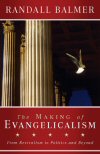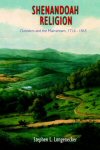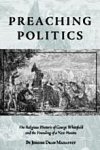Baylor Early American Christianity (3 vols.)
Digital Logos Edition
Overview
Since the Colonial era, America has fostered a unique environment of unprecedented religious toleration alongside intermittent persecution. This collection evaluates the distinct, diverse, and conflicted phenomenon that is American Christianity.
In The Making of Evangelicalism, Randall Balmer examines the key developments in American evangelicalism—from the awakenings of the eighteenth and nineteenth centuries, to the rise of the religious right. Preaching Politics traces the surprising and lasting influence of George Whitefield and his role in crafting a common worldview among the American colonies. Finally, in Shenandoah Religion, Stephen L. Longenecker uses the Virginia valley as a case study to reveal how the fabric of American pluralism was woven throughout the country.
In the Logos editions, these volumes are enhanced by amazing functionality. Important terms link to dictionaries, encyclopedias, and a wealth of other resources in your digital library. Perform powerful searches to find exactly what you’re looking for. Take the discussion with you using tablet and mobile apps. With Logos Bible Software, the most efficient and comprehensive research tools are in one place, so you get the most out of your study.
For more on the history of the church in America and religious freedom, check out Philip Schaff: Select Works on Religious Liberty (2 vols.)

Key Features
- Evaluates distinctive aspects of American Christianity
- Examines key developments in American evangelicalism
- Explores how the uniquely American religious pluralism developed in the seventeenth and eighteen centuries
Product Details
- Title: Baylor Early American Christianity
- Publisher: Baylor University Press
- Volumes: 3
- Pages: 671
- Christian Group: Evangelicals
- Resource Type: Histories
- Topic: Enlightenment, Modernity
Individual Titles
- The Making of Evangelicalism: From Revivalism to Politics and Beyond by Randall Balmer
- Shenandoah Religion: Outsiders and the Mainstream, 1716–1865 by Stephen L. Longenecker
- Preaching Politics: The Religious Rhetoric of George Whitefield and the Founding of a New Nation by Jerome Dean Mahaffey

With clear prose and a strong command of history, Randall Balmer chronicles the history of evangelicalism in the United States. Situating developments in evangelicalism in their wider historical context, Balmer demonstrates the ways American social and cultural settings influenced the course of the evangelical tradition.
Balmer argues that the history of American evangelicalism can be divided into four cultural shifts: the transition from Calvinist to Armenian theology in the embrace of revivalism, the shift from postmillennialism, the retreat into a subculture, and the rise of the religious right. Balmer outlines the distinctly American elements of evangelicalism in the Untied States and concludes with a manifesto directing where evangelicalism must go from here forward.
For those who seek a greater understanding of the peculiar successes of evangelicalism in the American environment there can be no better starting point than The Making of Evangelicalism.
—Harry S. Stout, Jonathan Edwards Professor of American Religious History, Yale University
Even those who might disagree with Balmer’s interpretations will profit from a serious reading and pondering of this engaging, lucidly written book.
—David S. Dockery, president, Union University
The Making of Evangelicalism exhibits the acumen we have come to expect from its author.
—The Journal of Southern Religion
Randall Balmer is Mandel Family Professor of Arts and Sciences and chair of the department of religion at Dartmouth College. He is the author of Thy Kingdom Come: How the Religious Right Distorts the Faith and Threatens America, God in the White House: How Faith Shaped the Presidency from John F. Kennedy to George W. Bush, and Mine Eyes Have Seen the Glory: A Journey into the Evangelical Subculture in America.

Surveying the religious pluralism of the eighteenth- and nineteenth-century Shenandoah Valley, Longenecker reveals how the fabric of American pluralism was woven. Calling worldliness the “mainstream” and otherworldliness the “outsidernesss,” Shenandoah Religion describes the transition certain denominations made in becoming mainstream and the resistance of others in maintaining distinctive dress, manners, social relations, economics, and apolitical viewpoints.
Informative and well written . . .
—CHOICE
[This work] will confirm Longenecker’s standing as the foremost religious historian of the Virginia backcountry.
—Robert M. Calhoon, professor emeritus of early American history, University of North Carolina, Greensboro
Stephen L. Longenecker is professor of history at Bridgewater College in Bridgewater, Virginia. A graduate of Johns Hopkins University, Longenecker is the author of Selma’s Peacemaker: Ralph E. Smeltzer and Civil Rights Mediation and Piety and Tolerance: Pennsylvania German Religion, 1700–1850.

Preaching Politics traces the surprising and lasting influence of one of American history’s most fascinating and enigmatic figures—George Whitefield. Jerome Mahaffey explores George Whitefield’s role in creating a “rhetoric of community” that successfully established a common worldview among the many colonial cultures. Using a rigorous method of rhetorical analysis, Mahaffey cogently argues that George Whitefield directed the evolution of an American collective religious identity that lay underneath the emerging political ideology that fueled the American Revolution.
This study of the convergence of religion and politics in eighteenth-century America is an altogether satisfying presentation suitable for use by undergraduate and graduate students alike.
—CHOICE
A must-read for students of eighteenth-century religion and politics alike.
—Harry S. Stout, Jonathan Edwards Professor of Religious History and chair, Department of Religious Studies, Yale University
This book is required reading for an explanation of the forces that led to American independence.
—Thomas H. Olbricht, distinguished professor emeritus of religion, Pepperdine University
Jerome Dean Mahaffey is associate professor and the John and Corrine Graf Chair of Mass Communication at Indiana University East.